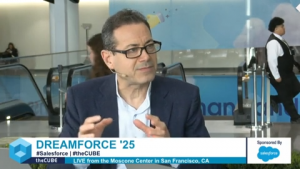 AI
AI
 AI
AI
 AI
AI
Agentic infrastructure is emerging as the connective tissue of the enterprise, reshaping how applications, data and artificial intelligence interact across every customer touchpoint.
In today’s rapidly evolving software landscape, organizations are breaking free from decades of siloed systems. The convergence of intelligent agents, unified data models and scalable infrastructure is redefining what it means to build enterprise platforms that think and act. This shift represents a fundamental re-architecture of enterprise operations — one that Salesforce Inc. is positioning itself to lead with its Agentforce ecosystem. The transformation is as sweeping as any seen in half a century, according to George Gilbert (pictured, left), principal analyst, data and AI, at theCUBE Research.

TheCUBE Research’s George Gilbert discusses agentic infrastructure during Dreamforce.
“In the agent revolution, it’s really the biggest transformation in enterprise software that we’ve gone through since the relational database — and maybe bigger than that,” Gilbert said. “Salesforce is the first major application vendor or platform vendor of any stripe who has all the pieces put together to be able to start unifying … all of the customer-related data and processes. It’s like no more islands.”
Gilbert spoke with theCUBE’s John Furrier (right) and Gemma Allen (center) at Dreamforce, during an exclusive broadcast on theCUBE, SiliconANGLE Media’s livestreaming studio. They discussed how Salesforce’s Agentforce platform, data unification, governance and ecosystem maturity are shaping the next evolution of enterprise AI applications and customer engagement. (* Disclosure below.)
The evolution of Salesforce’s platform shows how agentic infrastructure moves beyond automation toward orchestration — where data becomes both the fuel and the framework for intelligent operations. This vision depends on connecting agents to real-world business outcomes through unified, governed data pipelines that support decision-making at scale.
“The key point you made in there was data,” Gilbert explained. “In the age of AI, you program agents with data, not with code. The data that you have and how it’s shaped and how fresh it is determines how effective your agents are.”
As Salesforce’s architecture matures, new capabilities such as observability and reasoning tracking reveal the shift from experimentation to enterprise deployment. The introduction of agent testing centers and command platforms marks a turning point for agent governance and performance management. These advances make agentic infrastructure not just a technological layer but a control plane for how businesses manage decision intelligence, Gilbert noted.
“There is a testing center, which is like an observability platform,” he added. “It captures the reasoning traces and the data and the decisions and the actions … that each agent takes. It captures that fine thread. It’s the new big data.”
The maturing ecosystem now blends innovation with discipline. Salesforce’s Agentforce, Data Cloud and the expanding customer ecosystem create a unified environment for building, deploying and managing intelligent systems. The company’s deeper integration with partners and its emphasis on real-world deployments signal that the age of speculative AI is giving way to applied intelligence, according to Gilbert.
“Their ecosystem is as with any platform; their value is as much in the ecosystem as in the application and platform itself,” he said. “They’re also trying to reach out to a new audience … either the CIOs, chief data officers or chief technology officers. Those guys are not always connected to the business and success requires bridging both of those.”
With Salesforce’s latest releases, the narrative has shifted from hype to implementation. Agentic infrastructure has evolved into a new foundation for enterprise reinvention, one that turns fragmented systems into living, learning networks capable of adapting in real time.
“They are transforming from a customer 360 application company to an enterprise application platform company,” Furrier said. “The new platform is data and application data. I would submit and take the position that in order to do that, they have to be a data infrastructure company.”
Here’s the complete video interview, part of SiliconANGLE’s and theCUBE’s coverage of Dreamforce:
(* Disclosure: TheCUBE is a paid media partner for Dreamforce. Neither Salesforce, the sponsor of theCUBE’s event coverage, nor other sponsors have editorial control over content on theCUBE or SiliconANGLE.)
Support our mission to keep content open and free by engaging with theCUBE community. Join theCUBE’s Alumni Trust Network, where technology leaders connect, share intelligence and create opportunities.
Founded by tech visionaries John Furrier and Dave Vellante, SiliconANGLE Media has built a dynamic ecosystem of industry-leading digital media brands that reach 15+ million elite tech professionals. Our new proprietary theCUBE AI Video Cloud is breaking ground in audience interaction, leveraging theCUBEai.com neural network to help technology companies make data-driven decisions and stay at the forefront of industry conversations.